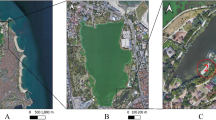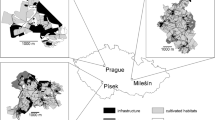Abstract
Iguana iguana is native to Central and South America, and was introduced into Puerto Rico in the 1970s as a result of pet trade. The invasive biology of this reptile has not been studied in Puerto Rico, where its negative effects may threaten local biodiversity. The purposes of this study were to: (1) estimate population densities of I. iguana; (2) describe some aspects of its reproductive biology; and (3) assess its potential impacts. Visual-encounter surveys were performed at Parque Lineal in San Juan and Canal Blasina in Carolina, while nesting activity data were collected at Las Cabezas de San Juan in Fajardo. Densities of I. iguana in Puerto Rico reached a maximum of 223 individuals ha−1, higher than in any known locality in its native range, and showed fluctuations related to seasonality. Our 2008–2009 observations at the nesting sites document that this population of I. iguana is a reproductively successful species, producing more than 100 egg clutches and 2,558 eggs with a 91.4% egg viability. The ability to proliferate in a low predation environment and the absence of good competitors are the major drivers of the population densities observed in Puerto Rico. We found evidence that I. iguana is threatening native biodiversity and impacting infrastructure, agriculture and human safety. Thus, a management program to control the species must soon be developed to prevent this invasive reptile from becoming more widespread and dominant in other localities around the island.



Similar content being viewed by others
References
Bomford M, Kraus F, Barry SC, Lawrence E (2009) Predicting establishment success for alien reptiles and amphibians: a role for climate matching. Biol Invasions 11:713–724
Carlo TA, García-Quijano CG (2008) Assessing ecosystem and cultural impacts of the green iguana (Iguana iguana) invasion in the San Juan Bay Estuary (SJBE) in Puerto Rico. Unpublished final report for SJBE. 30 Sep 2008
Casas-Andreu G, Valenzuela-López G (1984) Observaciones sobre los ciclos reproductivos de Ctenosaura pectinata e Iguana iguana (Reptilia: Iguanidae) en Chamela, Jalisco. An Inst Biol (UNAM) Serie Zool 55:253–261
Colón JA (1983) Algunos aspectos de la climatología de Puerto Rico. Acta Cient 1:55–63
Day ML, Thorpe RS (1996) Population differentiation of Iguana delicatissima and Iguana iguana in the Lesser Antilles. In: Powell R, Henderson RW (eds) Contributions to West Indian herpetology: a tribute to A. Schwartz. Society for the Study of Amphibians and Reptiles, New York, pp 136–137
Distel H, Veazey J (1982) The behavioral inventory of green iguana Iguana iguana. In: Burghardt GM, Rand AS (eds) Iguanas of the world. Noyes Publications, New Jersey, pp 252–270
Dugan B (1982) The mating behavior of the green iguana Iguana iguana. In: Burghardt GM, Rand AS (eds) Iguanas of the world. Noyes Publications, New Jersey, pp 320–339
Engeman RM, Smith HT, Constantin B (2005) Invasive iguanas as an airstrike hazard at Luis Muñoz Marín International Airport, San Juan Puerto Rico. J Aviat Aerosp Educ Res 14:45–50
Ewel JJ, Whitmore JL (1973) The ecological life zones of Puerto Rico and the US Virgin Islands. Research paper ITF-18. USDA, Puerto Rico
Harris DM (1982) The phenology, growth, and survival of the green iguana, Iguana iguana, in northern Colombia. In: Burghardt GM, Rand AS (eds) Iguanas of the world. Noyes Publications, New Jersey, pp 150–161
Hirth HF (1963) Some aspects of the natural history of Iguana iguana on a tropical strand. Ecol 44:613–615
Joglar RL (ed) (2005) Biodiversidad de Puerto Rico. Vertebrados Terrestres y Ecosistemas: Serie de Historia Natural. Editorial Instituto de Cultura Puertorriqueña, Puerto Rico
Kern WH (2004) Dealing with Iguanas in the South Florida Landscape. Fact Sheet ENY-714, entomology and nematology, Florida cooperative extension service, institute of food and agriculture science. University of Florida, Gainesville
Krysko KL, Enge KM, Donlan EM, Seitz JC, Golden EA (2007) Distribution, natural history, and impacts of the introduced green iguana (Iguana iguana) in Florida. Iguana 3:2–17
Loftin H, Tyson EL (1965) Iguanas as carrion eaters. Copeia 1965:515
Mermin J, Hoar B, Angulo FJ (1997) Iguanas and Salmonella marina infection in children: a reflection of the increasing incidence of reptile-associated salmonellosis in the United States. Pediatrics 99:399–402
Mermin J, Hutwagner L, Vugia D, Shallow S, Daily P, Bender J, Koehler J, Marcus R, Angulo FJ (2004) Reptiles, amphibians, and human Salmonella infection: a population-based, case-control study. Clin Infect Dis 383:253–261
Meshaka WE, Smith HT, Golden E, Moore JA, Fitchett S, Cowan EM, Engeman RM, Sekscienski CressHL (2007) Green Iguanas (Iguana iguana): the unintended consequence of sound wildlife management practices in a south Florida park. Herp Conserv Biol 2(2):149–156
Müller HV (1972) Ökologische und ethologische studien an Iguana iguana (Reptilia-Iguanidae) in Kolombien. Zool Bertr 18:109–131
Muñoz EM, Ortega AM, Bock BC, Páez VP (2003) Demografía y ecología de anidación de la iguana verde, Iguana iguana (Squamata: Iguanidae), en dos poblaciones explotadas en la Depresión Momposina, Colombia. Rev Biol Trop 51:229–240
Rand AS, Dugan BA (1980) Iguana egg mortality within the nest. Copeia 3:531–534
Rand AS, Dugan BA (1983) Structure of complex iguana nests. Copeia 3:705–711
Rand AS, Greene HW (1982) Latitude and climate in the phenology of reproduction in the green iguana (Iguana iguana). In: Burghardt GM, Rand AS (eds) Iguanas of the world. Noyes Publications, New Jersey, pp 142–149
Rivero JA (1998) The amphibians and reptiles of Puerto Rico, 2nd edn. Editorial de la Universidad de Puerto Rico, Puerto Rico
Rodda GH (1992) The mating behavior of Iguana iguana. Sm C Zool 534:1–38
Rodda GH, Jarnevich CS, Reed RN (2009) What parts of the US mainland are climatically suitable for invasive alien pythons spreading from everglades national park? Biol Invasions 11:241–252
Sakai AK, Allendorf FW, Holt JS, Lodge DM, Molofsky J, With KA, Baughman S, Cabin RJ, Cohen JE, Ellstrand NC, McCauley DE, O’Neil P, Parker IM, Thompson JN, Weller SG (2001) The population biology of invasive species. Annu Rev Ecol Evol Syst 32:305–332
Savage JM (2002) The amphibians and reptiles of Costa Rica: a herpetofauna between two continents, between two seas. University of Chicago Press, Chicago
Savidge JA (1987) Extinction of an island forest avifauna by an introduced snake. Ecol 68:660–668
Schwartz A, Henderson RW (1991) Amphibians and reptiles of the West Indies-descriptions, distributions, and natural history. University of Florida Press, Florida
Smith HT, Golden E, Meshaka WE (2007) Population density estimates for a green iguana (Iguana iguana) colony in a Florida State Park. J Kans Herpetol 21:19–20
Southeast Regional Climate Center (2010) 1971–2000 monthly climate summary for San Juan, PR. http://www.sercc.com/cgi-bin/sercc/cliMAIN.pl?pr8808. Accessed 01 June 2010
Thomas R, Joglar RL (1996) The herpetology of Puerto Rico: past, present and future. In: Figueroa J (ed) The scientific survey of puerto rico and the virgin islands: an eighty-year reassessment of the island’s natural history. The New York Academy of Sciences, New York, pp 181–200
Townsend JH, Krysko KL, Enge KM (2003) Introduced iguanas in southern Florida: a history of more than 35 years. Iguana 10:111–118
Townsend JH, Slapcinsky J, Krysko KL, Donlan EM, Golden EA (2005) Predation of a tree snail Drymaeus multilineatus (Gastropoda: Bulimulidae) by Iguana iguana (Reptilia: Iguanidae) on Key Biscayne, Florida. Southeast Nat 4:361–364
van Marken Lichtenbelt WD, Albers KB (1993) Reproductive adaptations of the green iguana on a semiarid island. Copeia 3:790–798
Wiewandt AT (1982) Evolution of nesting patterns in iguanine lizards. In: Burghardt GM, Rand AS (eds) Iguanas of the world. Noyes Publications, New Jersey, pp 119–139
Acknowledgments
We thank N. Velez, L. Santiago and many Joglar/Burrowes Lab students for assistance in the field. Compañía de Parques Nacionales de Puerto Rico, the Conservation Trust of Puerto Rico and its staff at Las Cabezas de San Juan Nature Reserve allowed us to use their facilities as our study sites. Valuable information was kindly provided by H. Horta, L. J. Rivera Herrera, R. Fuentes, E. Padilla, H. De Jesús García and P. F. Quiñones (USDA-WS). P. Burrowes, K. Levedahl, E. Torres and two anonymous reviewers contributed comments that improved earlier versions of this manuscript. Funding was provided by NSF-Funded PRLSAMP (Grant no. HRD-0114586), Proyecto Coquí, and the Conservation Trust of Puerto Rico. Specimens were collected under Puerto Rican Department of Natural Resources permit DRNA: 2009-IC-013.
Author information
Authors and Affiliations
Corresponding author
Rights and permissions
About this article
Cite this article
López-Torres, A.L., Claudio-Hernández, H.J., Rodríguez-Gómez, C.A. et al. Green Iguanas (Iguana iguana) in Puerto Rico: is it time for management?. Biol Invasions 14, 35–45 (2012). https://doi.org/10.1007/s10530-011-0057-0
Received:
Accepted:
Published:
Issue Date:
DOI: https://doi.org/10.1007/s10530-011-0057-0




